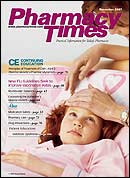Publication
Article
Pharmacy Times
Error Trifecta: Avandia, Coumadin, and Cardura
Author(s):
To avoid mix-ups with these and other commonly confused drug name pairs, alert staff and other practitioners about these types of errors.
Dr. Gaunt is a medication safetyanalyst and the editor of ISMPMedication Safety Alert!Community/Ambulatory CareEdition.
Figure 1

The Institute for Safe MedicationPractices has received severalreports involving mix-ups betweenthe antidiabetic agent rosiglitazone(Avandia) and warfarin (Coumadin).Although it is difficult to imagine that the2 could look alike when handwritten, theorder in Figure 1 illustrates how this confusioncould occur. In this case, a poorlyhandwritten prescription for Avandiawas taken to a community pharmacy,but Coumadin was dispensed in error.The error went unnoticed until thepatient developed a severe intestinalbleeding episode that required a completebowel resection. The issue is complicatedby the fact that both drugs areavailable in 2- and 4-mg tablets, and, witheither drug, patients are usually directedto take 1 tablet daily. These similaritiesincrease the likelihood that patientscould experience a dangerous mix-up.
Figure 2

Similarly, a long-term care pharmacyreceived a faxed copy of a handwrittenorder for doxazosin (Cardura) 1 mg hs(see Figure 2).The order was misinterpretedand dispensed as Coumadin 1 mg hs.Subsequently, the patient received 20doses of Coumadin instead of Cardurabefore the error was discovered during ahospitalization for uncontrolled hypertension.In another report, a prescriptionfor Cardura 2 mg was incorrectly enteredinto the pharmacy computer as Coumadin2 mg, but Cardura was correctlyselected from pharmacy stock andplaced into the vial. Unfortunately, due tothe initial processing error, the prescriptionwas refilled twice with Coumadinbefore the error was detected.
Figure 3

More recently, poor handwriting contributedto misinterpretation of 2 differentorders (see Figure 3), which were dispensedto the patient. The first errorocurred when the top order for Cardurawas misread as Coumadin. Then, tomake matters worse, the bottom orderfor Avandia also was misread asCoumadin. As a result, the patientreceived 4 mg of Coumadin in the morningand 2 mg at bedtime. Although weare unsure of this patient's outcome, thepotential for harm would obviously behigh. Two disease states (hypertensionand diabetes) may have been leftuntreated, and the patient may havereceived unnecessary or excessive anticoagulationfor an extended period oftime. Both of these medications are availablein 1-, 2-, and 4-mg tablets and aregenerally administered once daily. Inaddition, the names may look similarwhen poorly handwritten.
To avoid mix-ups with these and othercommonly confused drug-name pairs,alert staff and other health care practitionersabout these types of errors.Consider sharing a compilation of confusingprescriptions periodically with thepharmacy's frequent prescribers. Pharmacistsshould notify prescribers when amisinterpretation of one of their prescriptionshas contributed to an error ornear miss. Prescribers should be encouragedto include the medication's purposeon all prescriptions. Likewise, pharmacistsand nurses should verify a medication'spurpose (with the patient or prescriber)before it is dispensed or administered,especially for a high-alert medicationsuch as warfarin. For commonlyconfused name pairs, consider addingalerts in the pharmacy and physiciancomputer order entry systems. All practitionersmust educate patients abouttheir medications so that they are completelyfamiliar with each product's name(brand and generic), purpose, andexpected appearance.







